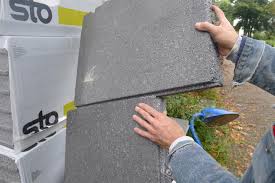List of Exterior Wall Insulation Contractors
This is a listing page for Exterior Wall Insulation Contractors recommended for you in your area.
Some brief information on Exterior Wall Insulation:
This is a great method of improving the u-value of your walls. For more information read the SEAI Homeowners Guide To Wall Insulation. There are various methods of exterior wall insulation but probably most proven is expanded polystyrene insulation EPS.
Expanded Polystyrene EPS if done properly there should be little or no thermal bridging in the wall spaces. Thermal bridges have lower values of thermal resistances in relation to the overall building structure. In this case, we are referring to the external wall.

EPS exterior wall insulation board
Thermal Bridges
These random small areas of heat losses in the building fabric can mount up, thus decreasing the positive effects of insulation. By choosing external wall insulation you can eliminate nearly all the thermal bridges.
You may be finding it difficult to decide between Exterior wall insulation, Internal wall insulation and Cavity Wall Insulation. If so the degree of thermal bridge elimination should be the deciding factor. External wall insulation can achieve almost a 100% insulation coverage. The highest result will usually come from new builds. It is easier to eliminate potential thermal bridging at the design stage.
If money is not an issue then go for exterior wall insulation. The other benefit for opting for this solution is to maximise heat retention in the walls of your your home.
We already covered the limitations of of insulating cavity walls, in particular, single hollow block walls. The thermal resistance value, no matter what type of infill being used, is limited. Single hollow block walls can only ever achieve 60 to 70% insulation coverage. However, cavity wall insulation (double leaf or double skin) can achieve over 90% insulation coverage It is important to be aware of these facts when upgrading insulating any part of your dwelling. Here is a link to a very well explained document on this topic from the UK Energy Saving Trust TB.
Advantages:
- Improved heat retention.
- Lower energy bills.
- No air leaks in the walls if airtight membranes are applied during the application stage.
- Significant improvement in the energy rating
Disadvantages:
- Altered texture to the external walls of your home. However, In many cases, the external insulation can look better than the original.
- High cost of works.
- A longer time to complete this type of installation due to the complexities of the works involved which could include cutting part of the existing concrete window sill.




